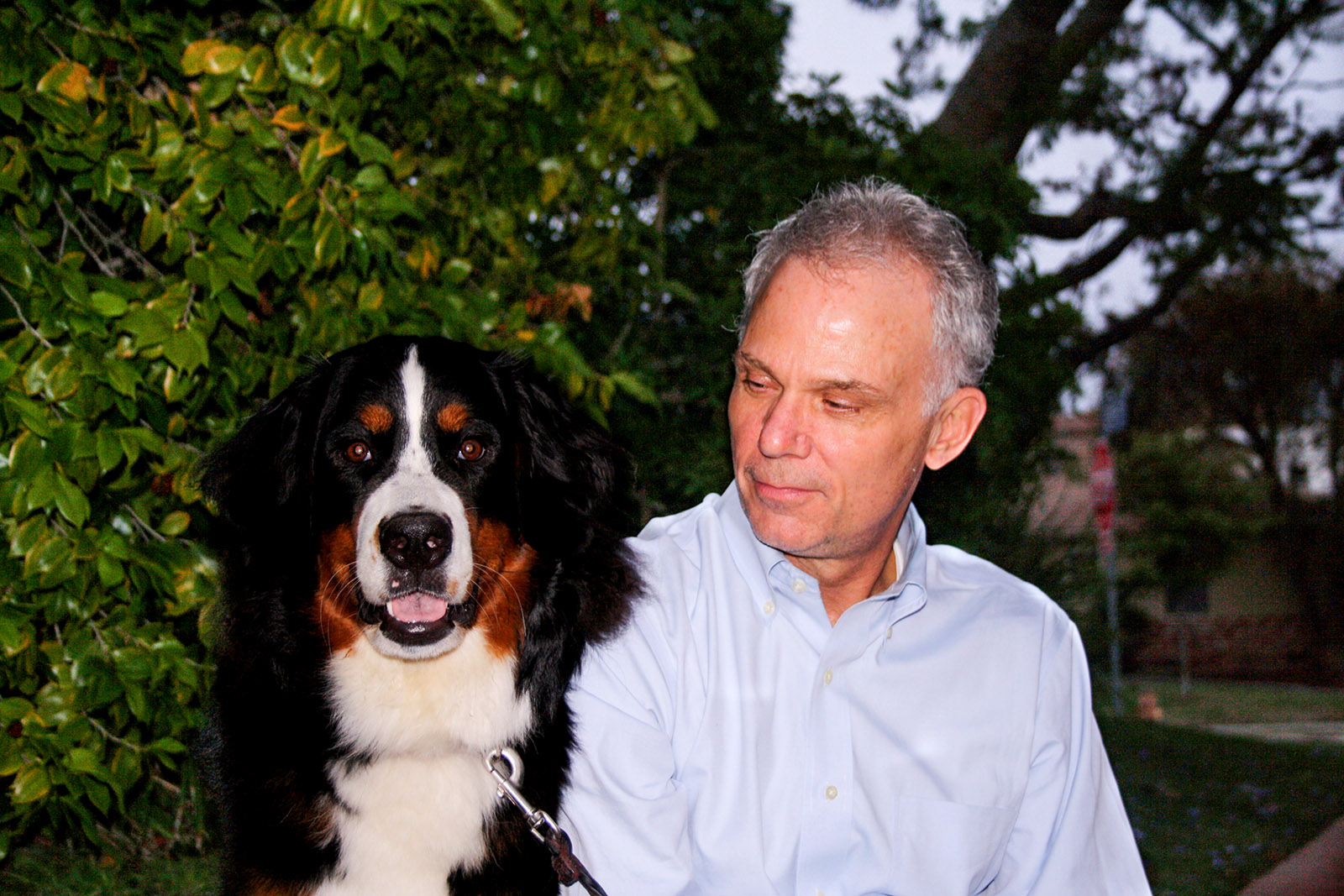Campus dogs leave impact on hearts of UCLA community

Clinical psychology professor Thomas Bradbury said students find comfort in his dog, Diamond, after difficult exams. (Courtesy of Thomas Bradbury)
By Kiera Kosciolek
June 5, 2016 1:43 p.m.
Students and professors often bring their dogs to UCLA, whether to help serve as an icebreaker in large classes or just for socializing around campus. Get to know some of these dogs and their owners.
Thomas Bradbury, professor of clinical psychology:
Clinical psychology professor Thomas Bradbury frequently finds himself at the center of a swarm of students when he walks his one year-old Bernese mountain dog, Diamond, across campus. He has been bringing his dogs to campus for years so they can learn how to interact with people.
He added students find comfort in Diamond after difficult exams.
“There’s something very primal about dogs, he said. “They don’t judge you, they don’t care about anything except paying attention to you and being with you.
If Diamond was to attend UCLA, she would be a great freshman, he added.
“She would be really attentive in class, but on the weekends she would be a party animal,” Bradbury said. “But, it would take her five years to graduate, maybe more. She gets distracted.”
On a campus as large as UCLA, Bradbury said having a dog is a way to make connections with both students and faculty.
“Dogs are really good for us because they get you out to meet your neighbors,” Bradbury said. “(Diamond) is a key that opens the door to a lot of interesting people and stories,” he added.
Claire McEachern, professor of English:

English professor Claire McEachern’s Irish wolfhound, Cordelia, may be large, but she is far from intimidating. Much like a typical college student, she prefers to sleep during class, McEachern said.
“She has this ability to look up exactly when the class is (over),” McEachern said. “If she had books and papers she’d be shuffling them. I think the students watch the dog instead of watching the clock.”
McEachern began bringing Cordelia to campus when she was 12 weeks old because she wanted to socialize her. Today, McEachern said Cordelia is shy but likes when students pet her.
“I think students are always happy to see her,” McEachern said. “Some of the classes I teach are larger, like (English)10A, so it’s kind of an ice breaker.”
Outside the classroom, Cordelia also allows McEachern to have more meaningful interactions with students than she would in class, she added.
“If you have a dog, it gives people a chance to talk to you about something other than their work,” McEachern said.
Mark Carlson, professor of music theory and composition:

Students have a theory that Jasper, adjunct associate music theory and composition professor Mark Carlson’s 11-year-old miniature schnauzer, is the real composer behind his music. Since 2009, Jasper has been a regular on campus, and spends most days in Carlson’s office or walking through the Court of Sciences. While roaming the campus, strangers often stop him and ask to pet Jasper after a bad day, Carlson added.
“Sometimes I feel like I’m walking a four-legged therapist,” Carlson said. “Everybody in the music department, even if they don’t know my name, will say hello to him.”
He added while Jasper is not the real composer behind his music, he thinks he would be a highly engaged UCLA student.
“He’s very interested in the world, but he’s also really bossy and headstrong, so he might be an argumentative student,” Carlson said.
Rosaleen Rhee, third-year graduate student in musicology:

Students in Rosaleen Rhee’s seminar classes will often make time before or after class to pet Kudu, her four-year-old border terrier.
“I love the natural interactions she has with the students, and I think it really lightens the mood,” said Rhee, a graduate student in musicology. “I’ve been teaching a freshman cluster course, and a lot of (students) would say this is their first time leaving home, so this reminds them of the dogs they left at home.”
Rhee started bringing Kudu to class last year because she needed a place to keep her while she was working, but has since seen the benefits of having dogs on campus.
“I don’t know how many people I’ve met just because I have a dog,” Rhee said. “Sometimes students just want to come and pet her even if I don’t know them.”
She added dogs serve as a way to bring everyone, from professors to students, together, even at a school as large as UCLA.
Faraz Ghadooshahy, fourth-year history student:

Wherever fourth-year history student Faraz Ghadooshahy goes on campus, his bulldog, Pierre, goes with him. From the steps of Powell Library to the lawn near Janss Steps, he and Pierre are inseparable, Ghadooshahy said.
“I spend a lot of time with my dog,” Ghadooshahy said. “It was more convenient for me to bring him to school and walk him (there) than for me to take time out of my day to (go back and forth).”
Ghadooshahy said his teachers have allowed him to bring Pierre to all his classes this quarter because Pierre is so quiet. In some cases, he said they didn’t even notice Pierre was there until after the class had ended.
“He lays down and doesn’t make any noise,” Ghadooshahy said. “He just kicks (back and relaxes).”
Ghadooshahy added more professors should consider bringing their dogs, since every dog he has encountered has been well behaved.
After 10 weeks of class with Pierre, Ghadooshahy said he is glad he took a chance and decided to bring him.
“Now I can’t go to class without (him).”


